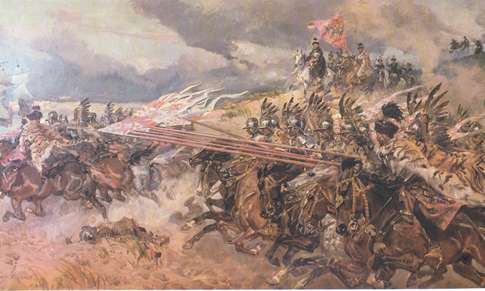
Battles and Campaigns
|
|
Swedish Polish War 1600 to 1609 Military Operations, 1605 In 1605 Charles IX, king since the previous year organised an army of around 12,000 men - composed of a large proportion of mercenary Germans as well as Dutch and Scots, and even some Poles and Hungarians. A political rebellion was developing in Poland and it meant that at the start of year the Sejm broke up without passing any new taxes for the army. Even so Chodkiewicz had managed by the summer to gather some 5,000 men of which 3,500 were for use in the field. The rest were barely enough to garrison a few of the major forts. The main forces stood at Dorpat while garrisons held Bialy Kamien, Felin, Dopart, Kies and probably Rakibor. Some 150 Polish-Hungarian infantry and 100 peasants garrisoned Dynemunt closing access to Riga from the sea while Riga itself had a strong garrison. The coastal road from Parnawa to Riga was left undefended due to lack of men, though this would in any case have been difficult as Sweden ruled the sea. Charles IX decided to strike at the most important town in Livonia - Riga. Its capture would allow military operations along the Dzwina and so cut of Livonia from the Commonwealth. Charle's limited number transport ships precluded the movement of all his forces by sea straight to Riga.
On news of the blockade of Riga, Chodkiewicz moved on around the 17th towards Riga, leaving most of his tabor at Dorpat. On 21st he reached Wolmar and news reached him that Riga was currently not in significant danger. Riga had at its disposal some few thousand defending inhabitants and a few hundred mercenaries. Chodkiewicz then also discovered that Lennartsson had landed at Rewel and may be moving south. There was a chance that that Lennartsson could be caught in the open, while the careful Mansfeld would have easy access to his supporting ships. Around the 23rd August Chodkiewicz moved his main forces north against Lennartsson. At the same time he sent a few banners of cavalry under Tomasz Dabrowy towards Riga to observe Mansfeld. Lennartsson meanwhile had initially decided to take advantage of Chodkiewicz's march south to capture Felin, however when he heard the enemy were returning north the Swedes aiming to avoid battle moved to Fickel (Vigala) and fortified themselves in a strong position between bogs and forests and formed field obstacles. Chodkiewicz arrived at Fickel around the 29th Aug and attempted to coax Lennartsson into the open. In this he failed and in an exchange of musket fire the Poles inflicted some 200 losses on the enemy. It was here that Chodkiewicz learnt of Charles IX's landing at Parnawa, which could threaten Felin, so on 1st September the Hetman left for Felin arriving on two days later. Lennartson took this opportunity to march to Parnawa to join Mansfeld, their combined forces were some 8,000 men. On 5th Charles IX led his forces along the coastal road, which was shielded from the east by forests and marshes, to Riga. At the same time his fleet escorted his forces, moving in parallel with them. They rested between 11th and 14th Sept at Salis. The belt of forests and marshes along the coast made it difficult for Chodkiewicz to orientate himself of the Swedish movements and almost certainly he expected the Swedes to return and move east towards Felin. He probably remained at Felin on 8th Sept or even until 14th. Some time here news reached him of the Swedish march south and he quickly moved to Wolmar, reaching it on 16th. Chodkiewicz, who was used to the previously careful Swedish movements and strategy, was not expecting a march to Riga. He felt too weak to fight a pitched battle with the combined Swedish force and he wanted to delay, waiting on reinforcements from Lithuania. While in Wolmar he received a false report that the Swedes were intending to attack him and decided to fight a defensive-offensive battle. In the region of Kies he crossed onto the left bank of the Gawa river, raising field defences from which to counter attack the Swedes. He waited until the 24th, by which time his tabor from Dopart joined him, when he received unexpected news that Charles IX had reached Riga the day before. Mansfeld having relatively weak forces had not really begun the siege of Riga. On 24th Charles has sent a delegation demanding capitulation, and when this was rejected the Swedes commenced the siege. This serious threat to Riga forced Chodkiewicz to move to relieve the town, despite the inherent risks with such a numerically superior enemy. In a fast two day march (25th-26th) he reached Kircholm (Salaspils) some 15km south east of Riga. |
|
![]()
